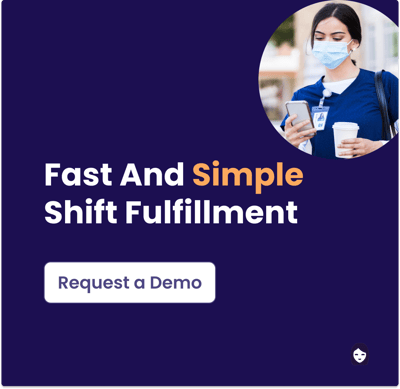
Innovation Will Be Critical For The Recovery Of Staffing In Healthcare
The COVID-19 pandemic has influenced an unprecedented human resources crisis in the healthcare sector. Staffing levels that have long been stretched thin were exacerbated by burnout, PTSD, and exhaustion amongst the nursing and personal support workers. Leaving organizations scrambling and stretched thin trying to fill shifts on a daily basis.
As we collectively make it through the Omicron wave, it is clear that no single solution will fix the staffing shortage. As a sector, we have to address the underlying factors influencing turnover and transform healthcare into an industry that skilled workers want to be in, to better attract and retain talent.
Healthcare leaders will need to turn to innovation to access solutions that can alleviate stress and help promote a happier and healthier workforce; starting with how they staff and schedule their facilities.
Removing Bottlenecks In staffing
The pandemic has highlighted what healthcare leaders already knew: manual scheduling and shift fulfillment no longer work. Pre-pandemic, manually calling out, emailing, and texting staff to fill open shifts could take upwards of 5-8 hours for a single open shift and would only prove to be 40-50% effective. Now adding the influx of unexpected shortages caused by staff isolation, burnout, and exhaustion, as well as turnover, healthcare administrators simply cannot find the coverage they need promptly. Leaving shifts understaffed and challenging the ability to provide quality care to residents and patients.
Manual shift fulfillment is no longer sustainable. Healthcare needs to rapidly scale their shift fulfillment capabilities and provide administrators with certainty that they will find critical coverage to alleviate the pressure.
 Centralized, automated scheduling and shift fulfillment remove the bottlenecks and stress experienced with manual scheduling and call-outs. Schedules can be saved as a template and repopulated in seconds. More importantly, shift callouts occur automatically and according to rule-based specifications, eliminating stressful administration. Meaning schedulers can fill more shifts, faster, freeing them to spend time on what matters the most: patient care.
Centralized, automated scheduling and shift fulfillment remove the bottlenecks and stress experienced with manual scheduling and call-outs. Schedules can be saved as a template and repopulated in seconds. More importantly, shift callouts occur automatically and according to rule-based specifications, eliminating stressful administration. Meaning schedulers can fill more shifts, faster, freeing them to spend time on what matters the most: patient care.
Identifying and preventing burnout
As staffing demands mount, the balance between providing care and preventing employee burnout has become increasingly imbalanced. Overworked employees leaving the sector are putting an added strain on the system, only worsening the issue.
Organizations have experimented with monetary incentives to retain and attract staff; however, this has mostly delayed them as exhaustion is at the core of the problem. To begin to recover staffing levels and stop the hemorrhage of skilled staff from leaving the sector, organizations must be able to identify and prevent burnout from within their staff.
Current scheduling methods make it difficult to understand the shift distribution within the team and empower their schedulers to shift hours away from high-risk employees.
Centralized scheduling builds transparency into hours worked by individual employees, highlighting staff that has passed desired thresholds, further identifying staff that could take on additional hours, and empowering them to pick up those shifts according to their preferences. By shifting hours away from overworked employees and lessening their burden, administrators can build a more engaged and optimized workforce while continuing to prioritize patient and resident care.
Improving Shift Coverage
Outbreak-driven absenteeism will continue to challenge the healthcare industry for the foreseeable future as COVID becomes an endemic problem. To face unpredictable staffing levels, facilities will need to rapidly adapt to new conditions and deploy staff to bolster shift coverage.
While centralized scheduling is not a new concept to healthcare, the pandemic has reinforced the necessity to build transparency into organization-wide scheduling to efficiently manage resources across departments and facilities. Providing appropriate shift coverage to support the care demand is a necessity when prioritizing the care and wellbeing of your patients. As staffing levels fluctuate, leveraging underutilized staff will continue to be a critical strategy to support the demand for care without burning out already overstretched employees.
With traditional scheduling methods, shift fulfillment across multiple departments and locations requires immensely complicated and rapidly changing spreadsheets. An innovation-driven solution, on the other hand, can autonomously fill shifts to shift fulfillment, while providing transparency and empowerment to staff. Teams seamlessly access their up-to-date schedules, monitor, and manage open shifts, and take on additional hours, according to their preferences.
The speed and visibility of the process provide an opportunity to enhance staffing strategies and long-term plans as the healthcare sector recovers and provides more desirable working environments to candidates.
How BookJane Can Help
BookJane is an all-in-one shift fulfillment platform that was built specifically to solve the challenges associated with staffing shortages in healthcare. We simplify complex schedules, manage overtime, and fill last-minute shifts by connecting internal and external resources to open shifts with automated call-outs and by empowering staff to accept those shifts through a self-service app.
.png?width=675&name=Group%203816%20(1).png)
With BookJane our clients can create and fill shifts in a matter of minutes vs. the hours required while using traditional call-out methods, increasing shift fulfillment by 40% and removing the administrative burden of scheduling and shift fulfillment.
To discover if BookJane is right for your organization, you can request a demo below:




